Exercises (650)
Light-Contact: Sensitisation level 4-6
Stimulate circulation
Partner work
Stage 4:
Two punches are connected fluently: From a standing position, competitor B attempts to connect two punches fluently and touch his opponent with both. After the series of punches, competitor A counters by taking one or two steps.
Stage 5:
Multiple punches to a moving target: Competitor A keeps his hands in the basic position and moves slowly and constantly in all directions, but does not actively defend. Participant B tries to touch his opponent as often as possible in succession and connect several punches. From time to time (e.g. after approx. 8 hits), participant A counters to check whether participant B is covered. After some time, the roles are switched.
Stage 6:
Adjust the distance to a fast-moving target and control the (punch) hardness: Participant A is constantly on the move and tries to dodge the punches from participant B using footwork. The defender gives feedback if the punch was too strong. After some time, the roles are switched.
Participant:
1 pair of boxing gloves
Line run with cube
Increase pulse
Group work
4-6 participants per group
6 lines are defined. The runner whose turn it is rolls the dice. According to the result, he must run to the corresponding line and back again.
Variant:
With two dice. The lower number indicates the repetitions, the higher number the line.
Per group:
1-2 cubes
Line support ball
Stimulate circulation
Group work
2 teams
Both teams try to place the ball behind a defined goal line in the opponent's half of the pitch. A player may run with the ball until an opponent touches him on the back. He must then pass the ball to a team-mate (no throwing). This ball exchange must take place within three seconds, otherwise possession of the ball changes.
Variant:
The participants have one or more game ribbons tucked into their trousers (approx. 2/3 visible). If the ball carrier's ribbon is snatched, he must give the ball to the opposing team.
1 ball (e.g. foam/softball, blitz ball, rugby)
x game ribbons/leashes ►team identification
Participant:
1-3 game ribbons ►Variant
Lyrics
Stimulate circulation
Group work
Each participant moves freely in the hall/area to a specific song selection. The sports leader can specify various forms of movement (crossing legs, circling arms, crouching, touching the floor, hopping, hopping with one leg, etc.). As soon as the participants hear defined words in the song lyrics, they must perform a task announced by the sports leader:
- Air jump
- Sit on the floor briefly
- Touch the floor briefly with your stomach
- Greet/hug a partner
Example:
- Song choice: "dr Parkingmeter" by Mani Matter.
- Task:
- "20gi" = push-up;
- "Outo" = stretch jump;
- "Poscht" = touch the floor with your back.
1 music system incl. music (specific song selection)
Mat sweeping
Stimulate circulation
Group work
2 teams
The mats are spread out in the hall, with one half lying on top with the wrong side up. One team now tries to turn the "right" side of the mats up, while the other team takes care of the mats on the other side. After each reversed mat, the team must change places and move on to another mat. The winner is the team that is able to turn more mats to their side after a certain playing time.
Variant:
Additionally large soft mats can be used, which may result in more points.
x soft mats (small)
x soft mats (large) ► Variant
Mat run
Stimulate circulation
Group work
The participants run in a criss-cross pattern around the mats (committee tents) distributed around the hall (in the grounds). Various forms of movement (e.g. circling arms, crossing legs, etc.) are integrated independently or according to the instructions of the sports leader. As soon as the sports leader calls out a number, all participants spread out on the mats (committee tents) according to the number called out. Whoever remains performs an additional task (e.g. a strength exercise such as 5 push-ups). If the number of people on the mat does not correspond to the number specified by the sports leader, these participants must also perform the additional task (excess participants should therefore be sent away).
x Soft mats (small)/firing tents (for in the field)
Mat jumping
Increase pulse
Group work
8-14 participants per group
The group lines up behind a starting marker. There is a large soft mat in front of the group. On the start command, a binomial (grasping hands) jumps onto the mat. After the jump, it is the next pair's turn to jump onto the mat (flying change after leaving the mat or clapping off the next binomial). The aim of mat jumping is to jump onto the soft mat in such a way that the mat is pushed as far forwards as possible. The winner is the group that gets their soft mat over a defined line or against a wall first. To prevent the mat from being pushed further forwards when climbing down, the mat must always be left in the direction of the goal.
Variant:
The participants jump onto the mat individually.
Per group:
1 soft mat (large)
1 colouring stick
Mat relay
Increase pulse
Group work
4-6 participants per group
One participant at a time sits on the mat (slippery side of the mat at the bottom) and is pulled round a turn by another participant. Back at the starting position, the positions are switched and the participant who was sitting on the mat pulls the next participant in the group.
Which group was the first to transport all participants sitting on the mat around the turning point and back?
Per group:
1 soft mat (small)
2 colouring sticks
Mat hiking
Increase pulse
Group work
6-8 participants per group
The participants sit under the mat (facing the target). The mat is now guided forwards with the help of the hands, whereby the sitting positions must always be changed (i.e. after the mat has passed over them, the participants must stand up and sit down again in front of the group in order to transport the mat further). Which group will be the first to cross the finish line?
Per group:
1 soft mat (small)
Memory relay
Increase pulse
Group work
4-5 participants per group
A memory sheet with signs/symbols (e.g. degree signs, circle, square, etc.), pictures (e.g. tree, star, house, etc.) or formulae (e.g. a2+b2=c2, 4+5x3=19, etc.) is located at the turning point. The runners memorise as many fields as possible so that they can enter them on a blank answer sheet at the start. The next runner is therefore well advised not to start immediately, but to communicate with the previous runner to clarify the status of the solution process. The first group to complete all the fields on the answer sheet correctly wins the relay.
Per group:
1 solution sheet
1 answer sheet
Writing materials
Human gates
Increase pulse
Group work
Groups of 2
Two players form a team and play against another team of two. One player from each team stands hip-width apart to form a goal (define playing areas). The inverted stick can be used as a defence aid. The other two players play against each other on the field and try to score a goal. At a signal from the game leader (e.g. whistle or shout), the players and "human goals" swap roles. In this form of the game, it is important to diligently switch opponents.
Variant:
The new "goal" remains in place when the roles are switched.
Pro Tn:
1 floorball stick
1 floorball
Mobilisation
Mobilisation of the joints / dynamic stretching
Individual work
Mobilisation of the following joints:
- Ankle
- Knee
- Hip
- Spine
- Shoulder
- Elbow
- Wrist
- Cervical vertebra
Variant:
In place of the sports leader, one participant gives the exercise. After each exercise, another participant takes on the role of leader.
No material required
Mobilisation
Mobilisation of the joints / dynamic stretching
Partner work
Mobilise the following joints together with your partner:
- Ankle
- Knee
- Hip
- Spine
- Shoulder
- Elbow
- Wrist
- Cervical vertebra
Variant:
In place of the sports leader, one participant gives the exercise. After each exercise, another participant takes on the role of leader
.No material required
Mobilisation
Mobilisation of the joints / dynamic stretching
Individual work
Mobilisation of the following joints with the use of an aid:
- Ankle
- Knee
- Hip
- Spine
- Shoulder
- Elbow
- Wrist
- Cervical vertebra
Variant:
In place of the sports leader, one participant gives the exercise. After each exercise, another participant takes on the role of leader
Per Tn:
1 ball ►baseball, blitzball/rugby/football, fistball, futsal/football, handball, FooBaSKILL, volleyball
1 stick ► floorball, intercrosse/lacrosse, Nordic walking
1 racket ►badminton/speedminton, smolball
1 throwing disc (frisbee) ►frisbee ultimate
1 elasticated rubber band/power tube/skipping rope/playing rope
1 gymnastics stick with elastic band
Mobilisation
Mobilisation of the joints / dynamic stretching
Partner work
Mobilisation of the following joints together with a partner and using an aid:
- Ankle
- Knee
- Hip
- Spine
- Shoulder
- Elbow
- Wrist
- Cervical vertebra
Variant:
Instead of the instructor, one participant leads the exercise. After each exercise, another participant takes on the role of leader.
Per group of 2:
1 ball ►baseball, blitzball/rugby/football, fistball, futsal/football, handball, FooBaSKILL, volleyball
1 stick ► floorball, intercrosse/lacrosse, Nordic walking
1 racket ►badminton/speedminton, smolball
1 throwing disc (frisbee) ►frisbee ultimate
1 elasticated rubber band/power tube/skipping rope/playing rope
1 gymnastics stick with elastic band
Mobilisation: Elbow
Mobilisation of the joints / dynamic stretching
Individual work
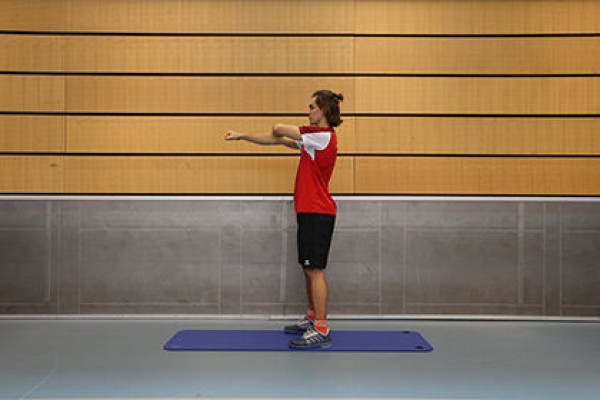

Hold one arm outstretched at chest height. The hand of the other arm grasps the elbow of the outstretched arm from below (bend the arm in front of the body). Alternately bend the playing arm over and under the bent arm/the pivot point formed and then extend it again. Switch sides from time to time (rotate the other arm).
Variant:
Exercise can also be performed in a seated or kneeling position.
No material required
Mobilisation: Elbow
Mobilisation of the joints / dynamic stretching
Individual work

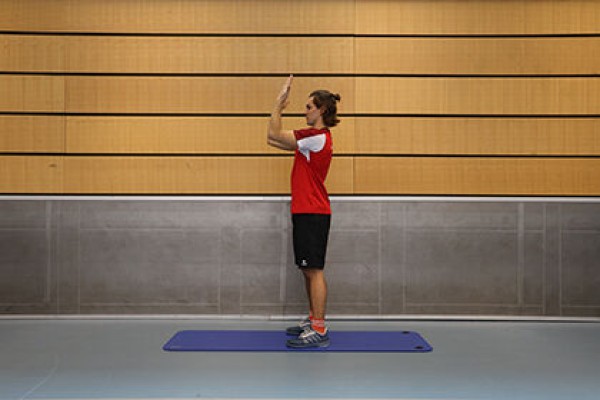
Stretch your arms out in front of you at chest height (palms facing down). Bend your arms (palms facing your face, forearms pointing upwards, upper arms remain stable) and return to the starting position (bend and stretch your arms). Change the position of the arms from time to time (e.g. after three repetitions) (palms of outstretched arms pointing upwards or downwards).
Variant:
Exercise can also be performed in a seated or kneeling position.
No material required
Mobilisation: Elbow
Mobilisation of the joints / dynamic stretching
Individual work








Hold one arm outstretched at chest height (with the aid in your hand). The hand of the other arm grasps the elbow of the outstretched arm from below (bend the arm in front of the body). Alternately bend the playing arm over and under the bent arm/the pivot point formed and then extend it again. Switch sides from time to time (rotate the other arm).
Variant:
Exercise can also be performed in a seated or kneeling position.
Pro Tn:
1 ball ►blitzball/rugby/football, handball, volleyball, floorball, intercrosse/lacrosse
1 racket ►badminton/speedminton, smolball
1 throwing disc (frisbee) ►frisbee ultimate
1 elastic rubber band//power tube/skipping rope/spinbond
Mobilisation: Elbow
Mobilisation of the joints / dynamic stretching
Partner work



Hold one arm outstretched at chest height and reach out to your partner. The hand of the other arm grasps the elbow of the outstretched arm from below (bend the arm in front of the body). Alternately bend the playing arm over and under the bent arm/the pivot point formed and extend it again to shake hands with the other participant. Switch sides from time to time (rotate the other arm).
Variant:
Exercise can also be performed in a seated or kneeling position.
No material required
Mobilisation: Elbow
Mobilisation of the joints / dynamic stretching
Partner work


Stretch your arms out at chest height and hold out your hands to your partner. Release your hands, bend your arms (palms facing your face, forearms pointing upwards, upper arms remain stable) and return to the starting position (bend and stretch your arms) to reach out to the other participant again. Change the position of the arms from time to time (e.g. after three repetitions) (palms of the outstretched arms point upwards or downwards or remain facing to the side).
Variant:
Exercise can also be performed in a seated or kneeling position.
No material required
Mobilisation: Elbow
Mobilisation of the joints / dynamic stretching
Individual work


Hold the slightly bent arm overhead (holding it up) and perform circular movements clockwise and anti-clockwise with the forearm (upper arm and wrist remain as stable as possible). Switch sides/arms from time to time.
Variant:
Exercise can also be performed in a seated or kneeling position.
No material required
Mobilisation: Elbow
Mobilisation of the joints / dynamic stretching
Partner work


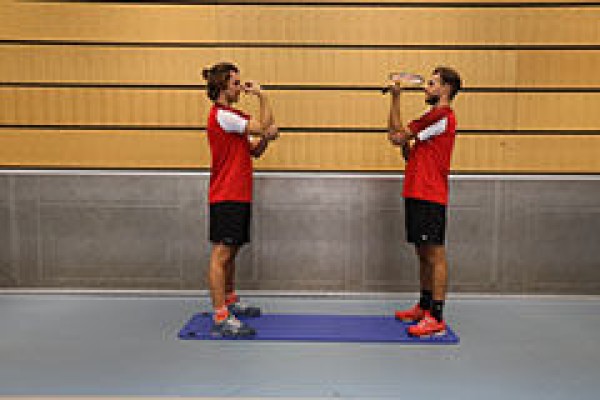





Hold one arm outstretched at chest height. The hand of the other arm grasps the elbow of the outstretched arm from below (bend the arm in front of the body). Alternately bend the playing arm over and under the bent arm/the pivot point formed and then extend it again. With their arms outstretched, the two participants pass the aid to each other (i.e. perform the exercise once without and once with the object). Switch sides from time to time (rotate the other arm).
Variant:
The exercise can also be performed in a sitting or kneeling position.
Per group of 2:
1 ball ►blitzball/rugby/football, handball, volleyball, floorball, intercrosse/lacrosse
1 racket ►badminton/speedminton, smolball
1 throwing disc (frisbee) ►frisbee ultimate
1 elastic rubber band//power tube/skipping rope/spinbond
Mobilisation: Elbow
Mobilisation of the joints / dynamic stretching
Partner work









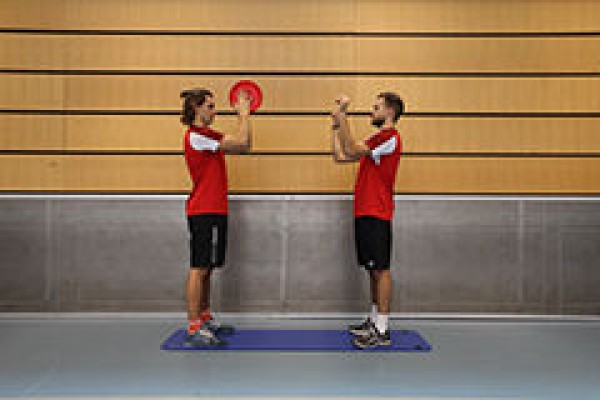


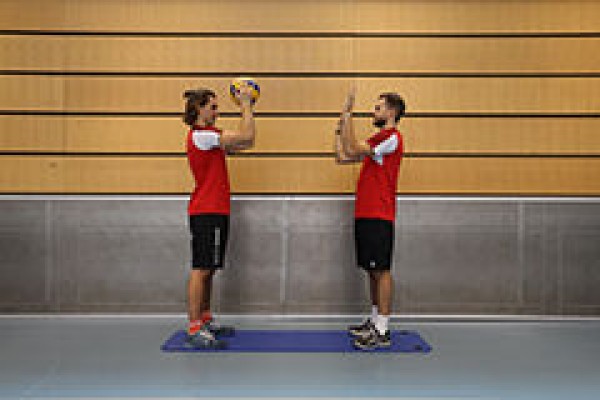


Arms stretched out at chest height in front of you and grasp the aid with both hands. One participant releases their hands from the aid, then the partners bend their arms (forearms pointing upwards, upper arms remain stable) and return them to the starting position (arms bent and stretched) in order to grasp the aid together again. In the next exercise, the other participant releases their hands from the aid, so the participants perform the exercise once without and once with the object. If possible, change the holding position of the arms from time to time (e.g. after three repetitions) (palms of the outstretched arms point upwards or downwards or always remain facing to the side).
Variant:
The exercise can also be performed in a sitting or kneeling position.
Per group of 2:
1 ball ►baseball, blitzball/rugby/football, fistball, futsal/football, handball, FooBaSKILL, volleyball
1 stick ► floorball, intercrosse/lacrosse, Nordic walking
1 racket ►badminton/speedminton, smolball
1 throwing disc (frisbee) ►frisbee ultimate
1 elasticated rubber band/power tube/skipping rope/playing rope
1 gymnastics stick with elastic band
Mobilisation: Elbow
Mobilisation of the joints / dynamic stretching
Individual work










Stretch your arms out in front of you at chest height and grasp the aid with both hands. Bend your arms (palms facing your face, forearms pointing upwards, upper arms remain stable) and return to the starting position (bend and stretch your arms). Change the position of the arms from time to time (e.g. after three repetitions) (palms of the outstretched arms point upwards or downwards or remain facing to the side).
Variant:
The exercise can also be performed in a seated or kneeling position.
Per Tn:
1 ball ►baseball, blitzball/rugby/football, fistball, futsal/football, handball, FooBaSKILL, volleyball
1 stick ► floorball, intercrosse/lacrosse, Nordic walking
1 racket ►badminton/speedminton, smolball
1 throwing disc (frisbee) ►frisbee ultimate
1 elasticated rubber band/power tube/skipping rope/playing rope
1 gymnastics stick with elastic band
Mobilisation: Elbow
Mobilisation of the joints / dynamic stretching
Individual work



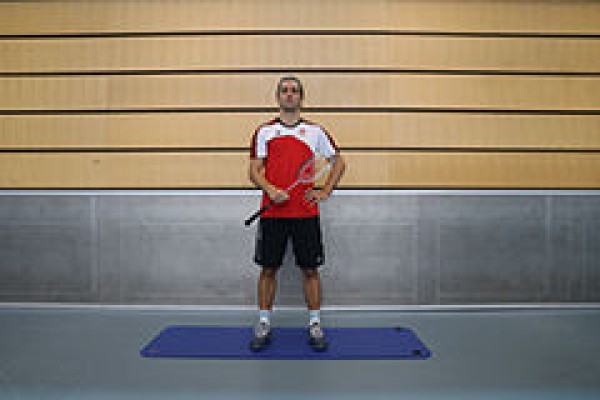


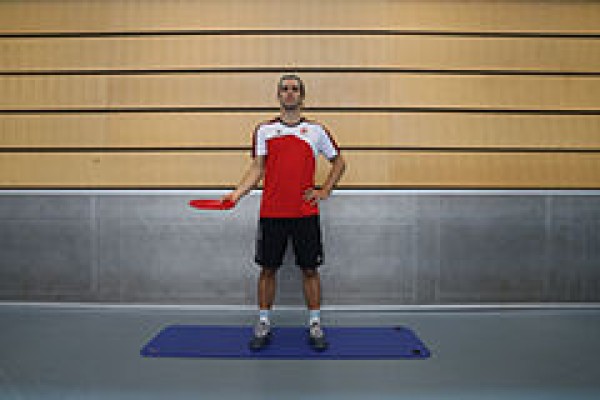



Hold the slightly bent arm with the aid in your hand overhead (holding it up) and perform circular movements clockwise and anti-clockwise with the forearm (upper arm and wrist remain as stable as possible). Switch sides/arms from time to time.
Variant:
Exercise can also be performed in a seated or kneeling position.
Per Tn:
1 ball ►blitzball/rugby/football, handball, volleyball
1 stick ►flat hockey, intercrosse/lacrosse, Nordic walking
1 racket ►badminton/speedminton, smolball
1 disc (frisbee) ►frisbee ultimate
1 elastic rubber band/power tube/jumping rope/spinbond
1 gymnastics stick with elastic band